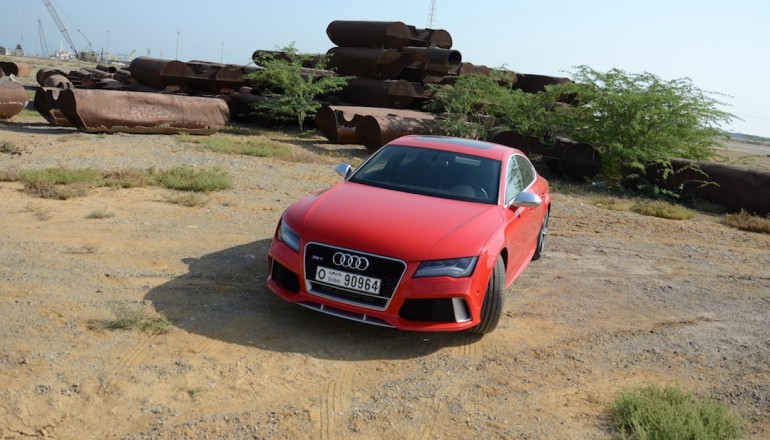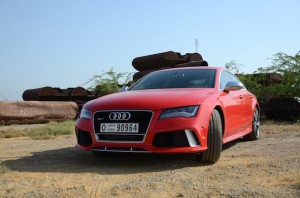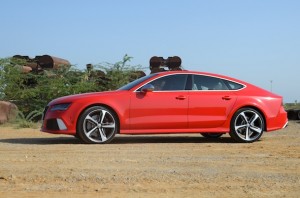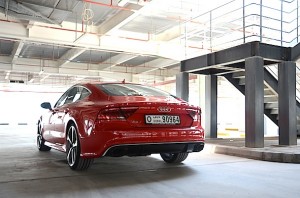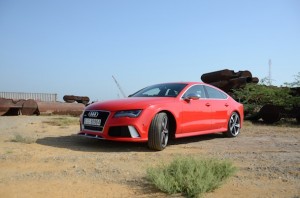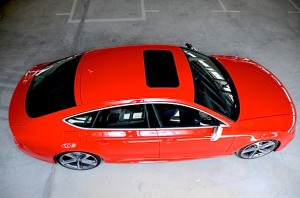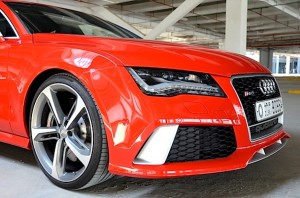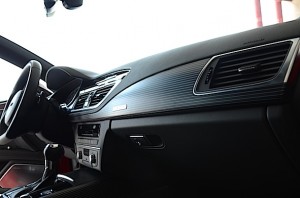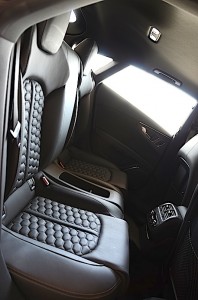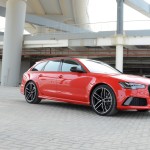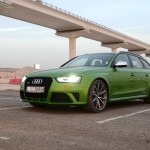Taking off from where we left the Audi RS6, there is not much of a difference between the RS7 and its estate edition. At the heart of it, and even in the façade – if you overlook the aluminium strips that frame the air dams – both shone with a freshly painted gleam in the brilliant Misano red, and imposing 21inch wheels. The interior felt the same, a tad less aggressive and a tad more elegant sans the red seat belts; even the boot space seems similar because the Sportback too comes with an abundant 535 L boot space. Which is why, the RS family is good to be compared within itself.
UPSIDE: Very powerful, practical boot space, assistance package
FLIPSIDE: Expensive, RS6 handling felt more engaging
The Price: Starting at AED 475,000 with the Aluminium Style Package and the works fulfilling half a million
The Drive
The Audi RS7 is driven by the same 4.0 L bi-turbo (3993 cc actually) with its 552 hp and 700 Nm of driving power. In handling as well, the longish heavy design of the RS7 is still very compliant; it really balances its power with its strong chassis and suspensions. Air suspensions are present in the RS7 as well. Fine tune it between the Dynamic and the Comfort modes with the choice of making your own mix, this car handles extremely well.
There is a bit of a body lean that I faced in the RS7, as well as a sort of shuffle during the downshifts, during which the only saving grace was the blowout. Though occasional, it was surprising because it’s the same engine that drives all these cars with the same 8-speed transmission.
Anyway, this phenomenon showed up only in the Dynamic mode. The Comfort was the state I was in for three days for fear of disrupting the happiness that my family found in the cabin of the RS7. But on the fourth day, only when I actually shifted to the Dynamic mode did I regret my conservative attitude that deprived me of the pleasure of the blowouts – it was more agile for the added torque while the comfort quotient of the car was never really compromised.
In fact in the Dynamic mode, while the car cruises around 2,500rpm, the slightest nudge rockets the rpm tachometer needle up to 6000 in a flash, which happens in the comfort mode too but takes longer – only after it explores what’s in store at 3000rpm.
Now, the exhaust notes really improve themselves in the Dynamic mode but it never gets to a brutal bass. It stays with an elegant tenor but the sub-woofer keeps playing out with the blowouts. The 0 to 100 on a casual stride came up in 4.7 seconds, but going by my gut, the 3.9 is rather achievable. The fuel efficiency clocked on the long term metre stood at 17.1 litres per 100kms, (5.85 km per litre) whereas mine, with a good mix of crawling city traffic and urban weekend drives was 223kms for 72 dirhams worth of super fuel (39 L). Go figure.
The Design
While the rear side of the Audi A7 split the whole universe into the likes and the like nots, the RS7 pulls many more of those like-nots onto the favourable side. Long and sharply raked towards the rear with the short stump, the RS7 looked really cool in the red but I should add to the advantage of the RS6 that the estate would draw more crowd – even those who hated hatchbacks – to like this avant-garde car.
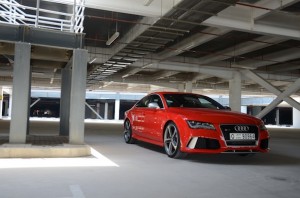 With its aggressive lower bumpers, air vents and mesh grills, and a totally different sort of a design, the RS6 stands out in the world of hatchbacks and estates! In the Sportback, the interiors feature the same design except for the addition of pin striped inserts – which is as elegant as Thursday dressing. The Valcona leather formed their little hexagons without the red stitching and the red seat belts that impressed the G on you were missing.
With its aggressive lower bumpers, air vents and mesh grills, and a totally different sort of a design, the RS6 stands out in the world of hatchbacks and estates! In the Sportback, the interiors feature the same design except for the addition of pin striped inserts – which is as elegant as Thursday dressing. The Valcona leather formed their little hexagons without the red stitching and the red seat belts that impressed the G on you were missing.
Cabin and Controls
Inside, the Audi RS7 cabin is as comfortable as the RS6 but, understandably, this car is again a four-seater. The RS7 interiors are marked by inlays designed like a pin stripe suit – as executive as it gets and just as dapper as it gets. The sunroof is small, not keeping in line with any of the new age sports executive sedans. But seriously, you don’t buy this car for the upward view! There is a blind spot monitor as part of the side assist and an advanced cruise control but most of the other stuff is missing in here, may be because a sports car doesn’t care!
Just as in the RS6, there is a lap timer amidst all the other controls and ample driver information too on a 7-inch vertical screen. The park assist works for both parallel and series parking but not for the slanted one. I’m yet to find one that does, so that is alright! The bumper was framed on the sides and below in aluminium strips which was not exactly my kind of thing but still gives a very slick and contemporary appearance to the RS7.
So, RS6 or RS7?
For the sheer adroitness of handling that you just don’t associate with an Estate, Audi RS6 inspires awe as much as it does for the impressiveness of its design. The RS6 has a unique power to stun and surprise but for those who would want a design that favours a sports car more, RS7 would fit the bill. The carbon fibre finesse in the RS6 beats the aluminium touches of the RS7 while in every other respect of fun and function, the cars draw a distinct parallel.
 Why, even in the rear storage with the seats up, where you would write off an unbeatable score to the RS6, The RS7 keeps up, making the choice between them a difficult one. If the price helps, while the RS7 begins at a slot AD 15,000 higher, and again, the RS7 test car with the style Aluminium package and some bits costing half a million. So, the final say is left to individual taste and the point you wish to make!
Why, even in the rear storage with the seats up, where you would write off an unbeatable score to the RS6, The RS7 keeps up, making the choice between them a difficult one. If the price helps, while the RS7 begins at a slot AD 15,000 higher, and again, the RS7 test car with the style Aluminium package and some bits costing half a million. So, the final say is left to individual taste and the point you wish to make!
Drive Courtesy: AVME
Pictures: Sudeep Koshy

